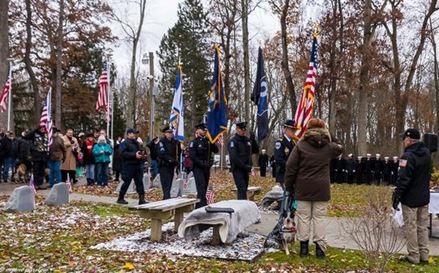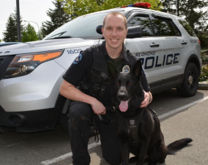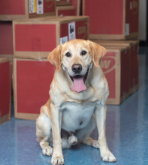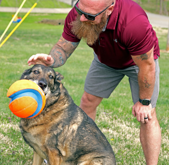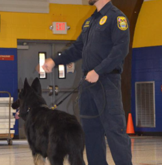Handler – Officer Shawn Penzak
Novi police dog honored with service, funeral at War Dog Memorial
“The group I trained with likes the puppies to bond (with the handler) from the beginning. It helped learn to train a dog,” Penzak said. “The No. 1 rule was that you can’t tell the puppy ‘no.’ Whatever it got into, it got into. There was a lot of trying to redirect him.” Moose was trained as a full utility dog — tracking, narcotics, protection, area and building searches. “He would work a 12-hour shift and not lay down — he’d watch me all the time,” Penzak said. “It’s quite a bond.” Moose probably could have worked another couple of years, Penzak said, but he wanted the dog to be able to enjoy some retirement. “We trained every Sunday. Somehow, he knew when Sunday fell. He’d go nuts in the bed (each Sunday),” Penzak said. “It took a few months for him to realize he wasn’t going for training.” When Penzak brought home his new police dog, Roque, a Dutch shepherd, he said Moose got along great with the newcomer. “Until we made the switch — Moose wasn’t happy about it. He adjusted to a new job to protect the home,” Penzak said. When Moose died in September, it was unexpected. He’d had a check-up earlier in the summer and was fine. There was a slight indication that Moose might have developed a narrowing of the spine that is common in German shepherds, Penzak said. “He never acted like there was a problem. He was Moose being Moose. He went to sleep and didn’t wake up. That’s what I always wanted for him,” Penzak said. Moose is the second Novi canine to be buried at the War Dog Memorial, located at Milford and 11 Mile roads. There are currently 23 dogs which have been buried at the memorial — about 40 percent military dogs, 40 percent police dogs and the remainder other dogs, such as those trained for search and rescue. There is a full ceremonial burial that includes a bagpiper, an honor guard, a team of eight German shepherds that escorts the remains to a table of honor, an invocation, reading of the biography, a presentation of a folded American flag to the handler and “Amazing Grace” performed on the bagpipes. The German shepherds howl for 30 seconds as a salute to a fallen comrade and there is a missing dog formation. “We do four or five funerals a year — I never know. It’s bittersweet. I hate to get the phone call,” said Phil Weitlauf of the War Dog Memorial. “We’re pretty involved with the canine units all over Michigan. For the units in a 50-mile radius, they like the dog to be interred here. Farther out, it’s too far for them to visit.” Through yearly canine training in Alpena, Penzak said he was aware of the War Dog Memorial. “The service is something to see. It’s beautiful. Unfortunately, it was such a cold day. There were vets who volunteer, a youth group,” Penzak said. “If you’ve never been to one, it was really touching. It was put together very well.” Weitlauf recalls the description of a handler whose dog was being buried at the War Dog Memorial — he called it the Arlington for military working dogs. “It made us feel honored as we had accomplished our goal to honor these heroic (dogs) for their service to our country,” he said.
